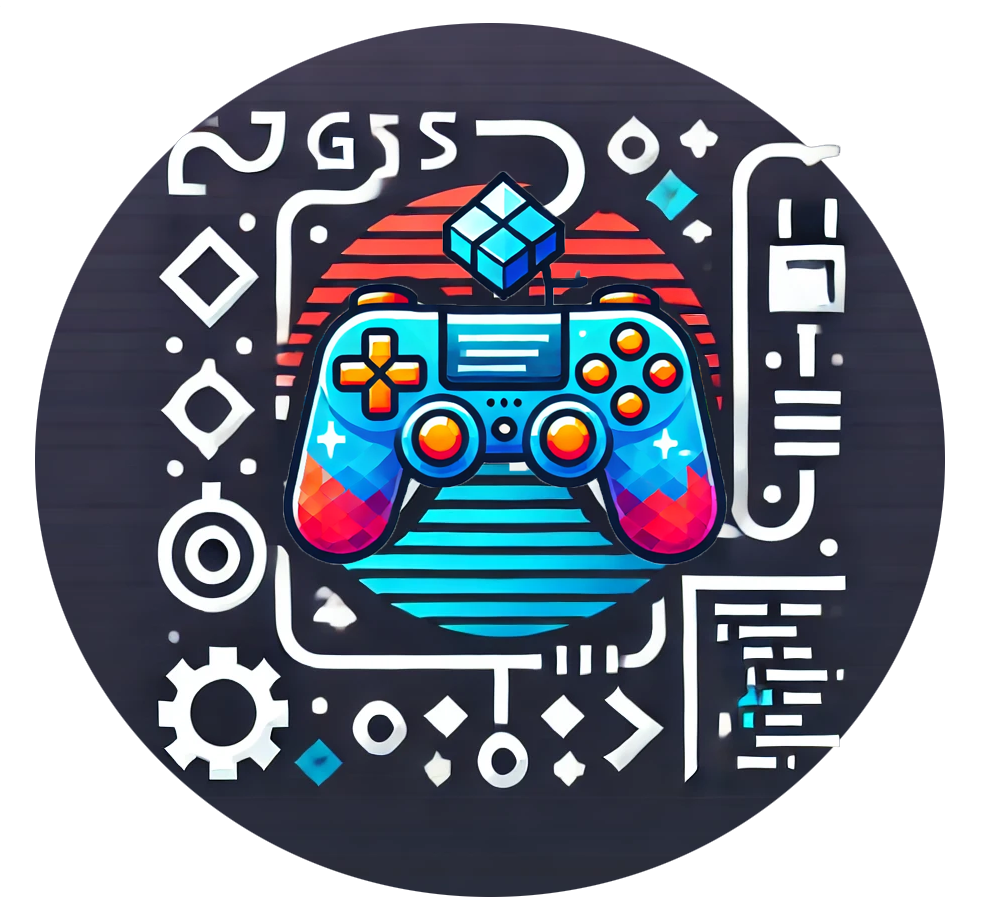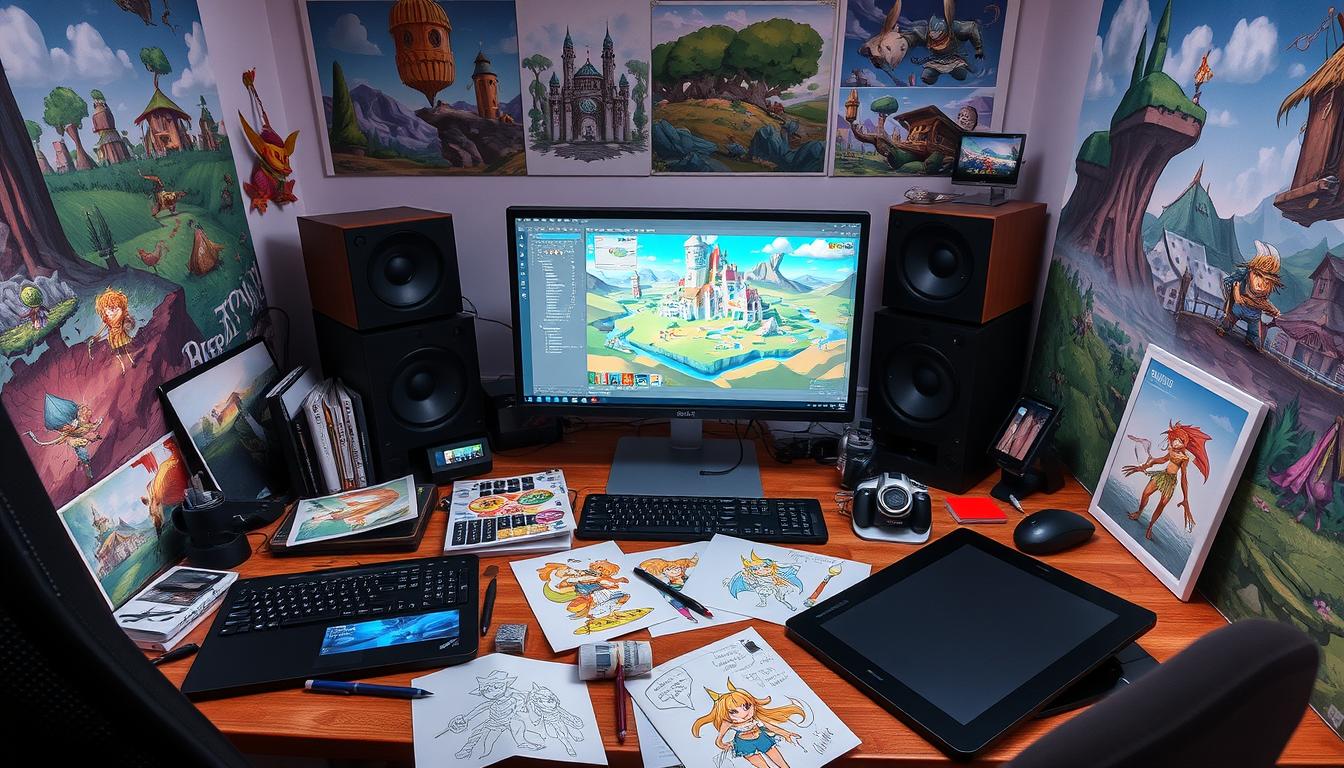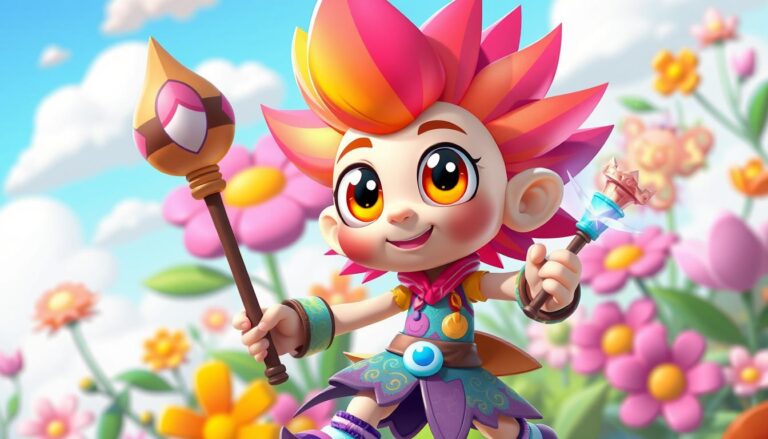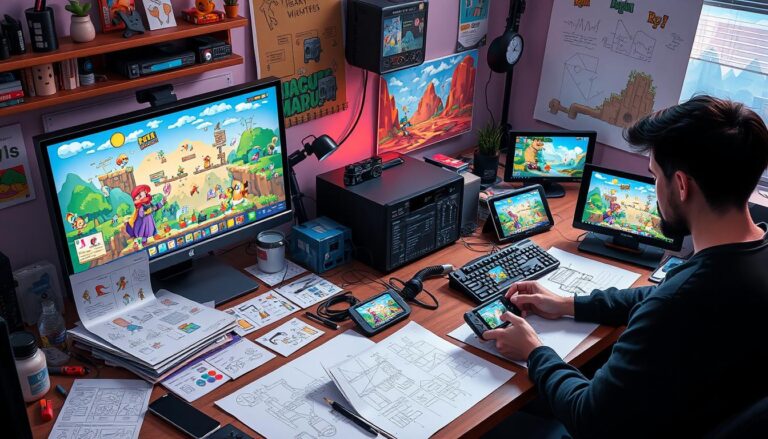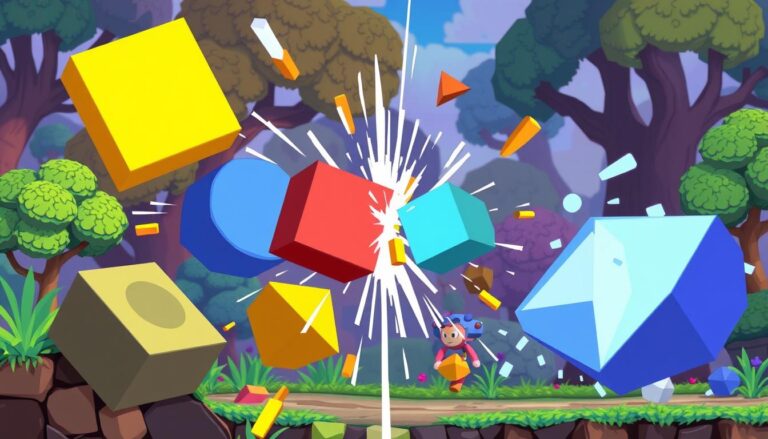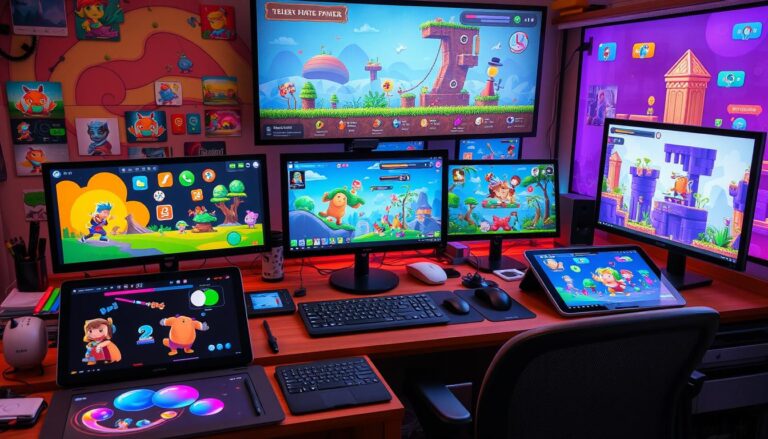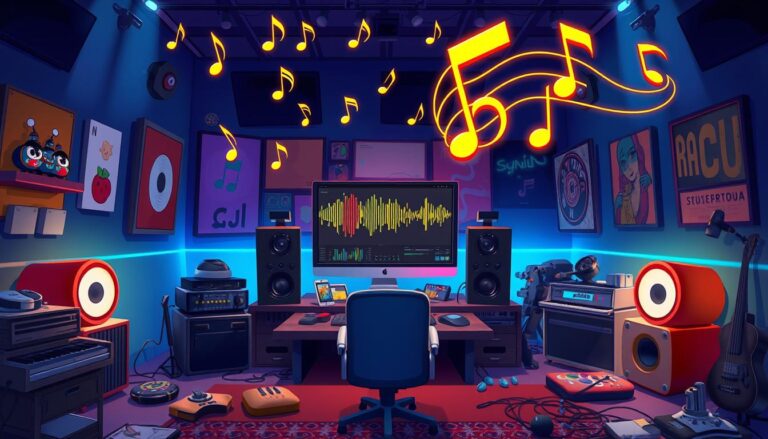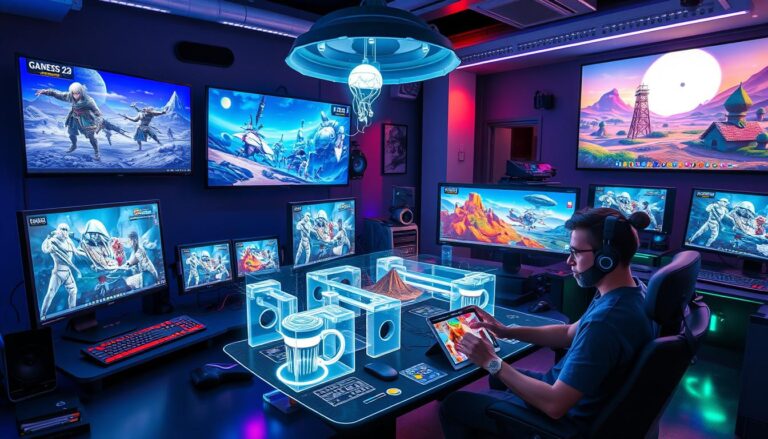What Skills Are Needed to Become a 2D Game Developer?
The world of 2D game development is full of excitement and challenges. It needs a mix of technical skills, creativity, and a love for making games. You’ll need to know programming languages, visual arts, and game design to succeed.
The gaming industry is booming, and there’s a big need for 2D game developers. The International Game Developers Association found that 63 percent of game developers make over $50,000 a year. In the US, game developers earn an average of $74,838, as Glassdoor shows. These numbers show that a career in 2D game development can be very rewarding.
To be a 2D game developer, you need to know programming languages and game engines. Skills in Java and using tools like the Android SDK are important. You also need to understand game design, including level design and user experience.
But it’s not just about technical skills. You also need to be creative. Knowing how to create 2D graphics, pixel art, and animation is key. Sound design and audio integration also play a big role in making games great.
There are many ways to work in 2D game development, from solo projects to team work in big studios. No matter your path, managing projects and knowing how to work well in a team are crucial. These skills help you go from idea to finished game.
Understanding the Role of a 2D Game Developer
The game industry has many career paths for 2D game developers. They can work on indie games or in big AAA studios. Knowing these options helps new developers plan their career.
Different Career Paths in Game Development
2D game developers can choose from many paths. Some work alone, handling all game aspects. Others join big studios, focusing on specific tasks like programming or art.
The industry keeps growing, offering chances in mobile, console, and PC games.
Solo vs. Team Development
Choosing to work alone or with a team affects a developer’s path. Solo developers handle everything, needing many skills and discipline. Team work lets developers focus on their strengths, like coding or art.
Industry Overview and Opportunities
The game industry is booming, with a market value expected to hit over $200 billion by 2023. This growth means lots of chances for 2D game developers. Indie games like Stardew Valley show solo developers can make big impacts. AAA studios offer steady careers and big projects.
| Indie Game Development | AAA Game Studios |
|---|---|
| Creative freedom and full control over the project | Structured career paths and resources |
| Opportunity to create innovative and unique games | Exposure to high-profile, large-scale projects |
| Lower overhead and operational costs | Collaborative work environment with specialized teams |
| Potential for greater financial rewards from successful titles | Stable employment and benefits |
Understanding the different paths and the industry helps 2D game developers make smart choices. This way, they can succeed in the ever-changing game industry.
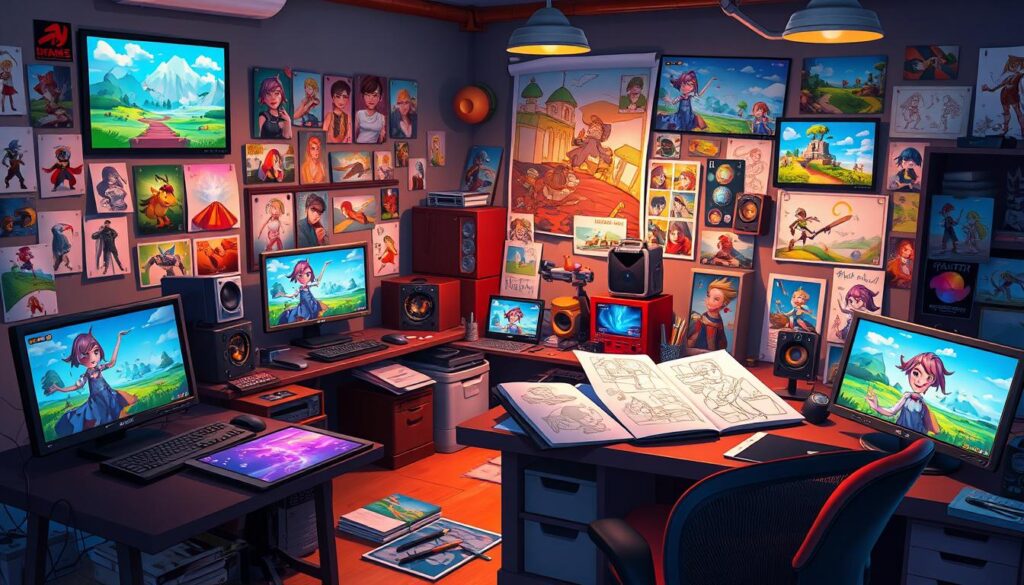
Essential Programming Skills for Game Creation
Making great 2D games starts with solid programming skills. Game developers need to know popular programming languages and how to use visual scripting tools. They also need to understand game engines. These skills help bring their game ideas to life.
Popular Programming Languages
The game world uses many programming languages. C# is a top choice for Unity games, making it easy to create games. C++ is great for Unreal Engine games because it’s powerful. For beginners, GDScript in Godot engine is easy to learn.
Visual Scripting Solutions
Visual scripting tools are perfect for beginners. Tools like Unity’s Bolt and Unreal Engine’s Blueprint let you create games easily. They’re great for learning game programming basics.
Game Engine Fundamentals
Game engines like Unity, Unreal Engine, and Godot are key for game making. Knowing how to use them is crucial. You’ll learn about sprites, physics, and scripting.
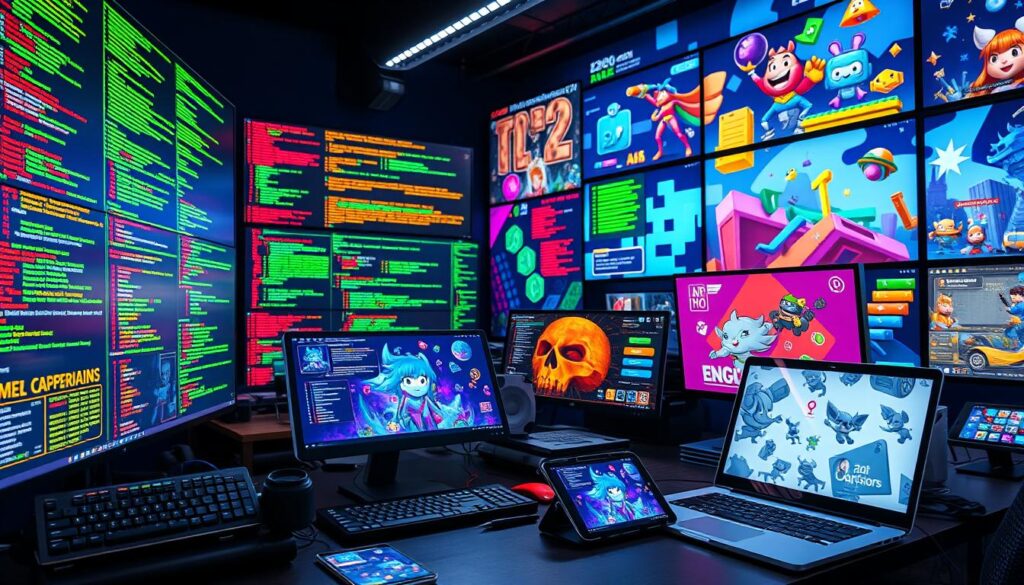
Knowing programming languages, visual scripting, and game engines opens up many possibilities. The game industry is always growing, offering new chances for those who learn these skills.
2D Game Development Tools and Technologies
As a 2D game developer, you have many tools and technologies at your disposal. These include powerful game engines and easy-to-use asset creation software. They are key to bringing your 2D game ideas to life.
Unity is a top choice for 2D game development, known for its flexibility and ability to run on many platforms. Unreal Engine is great for high-quality 2D games, thanks to its advanced graphics. Godot Engine, a free and open-source option, is popular among indie developers and hobbyists for its features without royalty fees.
For creating 2D art, developers use graphics software like Adobe Photoshop, GIMP, and Aseprite. These tools are essential for making sprites, backgrounds, and UI elements. They support pixel art, vector graphics, and animation, ensuring your game looks great.
Git is crucial for managing versions and teamwork in game development. It helps track changes, keep code consistent, and supports teamwork, even when developers are far apart.
Integrated Development Environments (IDEs) and code editors, such as Visual Studio Code, IntelliJ IDEA, and Sublime Text, make coding easier. They offer features like syntax highlighting, code completion, and debugging. These tools are vital for writing your game’s logic and functionality.
Asset stores like the Unity Asset Store, Unreal Engine Marketplace, and Itch.io offer a wide range of pre-made 2D game assets. These can save time and let developers focus on their game’s core aspects.
By using these 2D game development tools and technologies, you can make your game creation process smoother. You can also improve your game’s visual quality and bring your ideas to life more efficiently.
| Tool | Description | Key Features |
|---|---|---|
| Godot Engine | A free and open-source game engine with no royalties, appealing to indie developers and hobbyists. |
|
| GameMaker Studio 2 | Offers a drag-and-drop functionality for game development without the need for extensive coding, suitable for beginners. |
|
| Unreal Engine 5 | Features advanced technologies for high-quality 2D and 3D game development. |
|
There are also open-source JavaScript libraries like Crafty.js, Pixi.js, and Phaser.io for 2D game creation. They offer a wide range of features and tools tailored for 2D games.
Mastering Visual Arts and Graphics Design
Visual art skills are key for 2D game developers. They need to create engaging sprite animations and pixel art. This makes the game assets look great and is vital for success.
Sprite Creation and Animation
Sprite animation is at the core of 2D game development. Developers must know how to make characters and objects move smoothly. They need to understand frame-by-frame animation, timing, and creating seamless loops.
Tools like Adobe Photoshop and Aseprite help with sprite creation and animation.
Pixel Art Fundamentals
Pixel art is loved in indie gaming. To master it, you need to focus on details and color palettes. Each pixel must be placed with care.
Developers should aim to create pixel art that fits the game’s look and improves the player’s experience.
UI/UX Design Skills
Good UI/UX design is crucial for 2D games. Developers must design interfaces that are both beautiful and easy to use. They need to know about color, typography, layout, and interaction design.
Tools like Adobe Illustrator and vector graphics software are used for UI/UX design.
By improving their visual arts and graphics design, 2D game developers can make games that are both stunning and fun. These games will grab players’ attention and stand out in the market.
Game Design and Mechanics
Making a great 2D game needs a deep grasp of game design. As a 2D game developer, knowing the basics is key. Every part of the game, from levels to mechanics, must be well-planned to keep players hooked.
Designers focus on making gameplay smooth and fun. The game should be easy to get into and hard to put down. Whether it’s jumping, exploring, or fighting, the game should feel natural and engaging.
Creating great levels is also crucial. Designers aim to make levels that are fun, challenging, and rewarding. They balance the game’s difficulty and pace to keep players excited and motivated.
Good 2D games also understand what makes players tick. They use design tricks like rewards and player choices to make the game more enjoyable. This way, players feel more connected to the game.
To be a top 2D game developer, you need to master game design. It’s about making mechanics and levels work together to create a fun game. This skill is what makes the best 2D games stand out.
| Game Mechanic | Prevalence in Successful Games |
|---|---|
| Action Mechanics | 70% of successful games |
| Strategy Mechanics | 60% of top-rated puzzle games |
| Exploration Mechanics | 80% of open-world adventure games |
| Resource Management Mechanics | 75% of games requiring strategic resource allocation |
| Role-Playing Mechanics | 90% of popular MMORPGs |
| Flow Mechanics | 50% increase in user engagement and retention |
| Motivation Mechanics | 40% boost in player activity |
| User Experience Mechanics | 65% enhancement in player satisfaction |
| Player Progression Mechanics | 70% increase in player satisfaction and retention |
| Player Agency Mechanics | 55% rise in player immersion and engagement |
Using these game design principles well can make a 2D game much better. Developers who focus on these elements can create games that players love and keep coming back to.
Sound Design and Audio Implementation
Audio is key to making 2D games feel real. Game developers need to know about music, sound effects, and how to mix them. This knowledge helps make their games better and more fun to play.
Music Production Basics
Making a good game soundtrack is important. Developers can use tools like Ableton Live or FL Studio to create music. They can also adjust the music to fit the game’s look and feel.
Sound Effect Creation
Good sound effects make a game come alive. Developers can use software like Audacity to make or edit sounds. It’s all about making sure the sounds fit well with the game’s music and actions.
Audio Integration Tools
Tools like Unity and GameMaker help developers with audio. They can change how sounds and music are heard in the game. Knowing how to use these tools is key to a great audio experience.
Learning about game audio, sound effects, music production, and audio integration is vital. It helps developers make games that players love. By focusing on these skills, they can make their games stand out.
| Audio Integration Tools | Key Features |
|---|---|
| Unity Audio Mixer | Allows for advanced audio mixing and control, including volume, pitch, and effects. |
| GameMaker Studio 2 Audio System | Enables developers to manage audio assets, set up sound channels, and control playback. |
| FMOD Studio | Provides a comprehensive suite of tools for creating, mixing, and integrating complex audio systems. |
Project Management and Development Workflow
Effective project management is key for a successful 2D game. Developers need to know the game development cycle, from start to finish. Agile methods like Scrum, Kanban, and Lean help manage tasks and team work.
Time management and clear communication are vital, even for solo developers. Knowing how to publish games, including platform needs and submission steps, is crucial. Developers should also understand how to use player feedback to improve their games.
Tools like Jira, Trello, and Asana help game development teams manage projects. They offer features for Kanban boards, sprint planning, and tracking issues. These tools make the game development process smoother, improving workflows and ensuring quality products on time.
